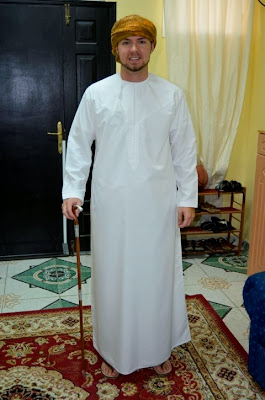... or how to wear traditional dress and look good doing it!
Our host country celebrated their National Holiday recently, and to get in on the festive spirit, my husband decided to wear the local garb for the day.
So here is the process of getting ready:
(It was pretty cute - the day of the Eid, he was so excited! He laid out his clothes the night before and got up early to get ready.)
We begin with the undergarment layer. The "skirt" is called a wazar. Getting it tied around and then the ties laid flat enough to not look bulgy under the outer robe can be a bit of a challenge.
Once the under layer is on, and the robe goes over top, it is time to work on the head scarf. It starts as a large square-shaped piece of fabric, folded in half to a triangle. Then the point of the triangle is laid on the back of the neck. The longest straight side is in the front and is then folded and rolled all the way to the forehead. Then the extra fabric ends are wrapped in a circle all the way around the head and tucked in back. He has become quite a pro at this in my opinion!
Then you have to make sure you have your local cane/walking stick. It is a necessary prop for the National Dance.
This is a traditional local greeting among men called a "khashem." The guys shake hands and touch noses.
This is a very popular picture pose they call, "hibatane" or "two pieces."
I came for a few minutes and dressed up too! It was so much fun to see their smiles at seeing us appreciate their culture. I loved taking pictures with many of his students too.
Our host country celebrated their National Holiday recently, and to get in on the festive spirit, my husband decided to wear the local garb for the day.
So here is the process of getting ready:
(It was pretty cute - the day of the Eid, he was so excited! He laid out his clothes the night before and got up early to get ready.)
We begin with the undergarment layer. The "skirt" is called a wazar. Getting it tied around and then the ties laid flat enough to not look bulgy under the outer robe can be a bit of a challenge.
Then you have to make sure you have your local cane/walking stick. It is a necessary prop for the National Dance.
All ready for work!
He and his American co-worker who joined him in donning local dress were a major hit at work!
This is a traditional local greeting among men called a "khashem." The guys shake hands and touch noses.
I came for a few minutes and dressed up too! It was so much fun to see their smiles at seeing us appreciate their culture. I loved taking pictures with many of his students too.
These pictures were sent to me by his students and other people in the community. Some of these were circulating on Twitter!











































